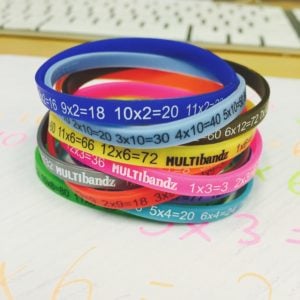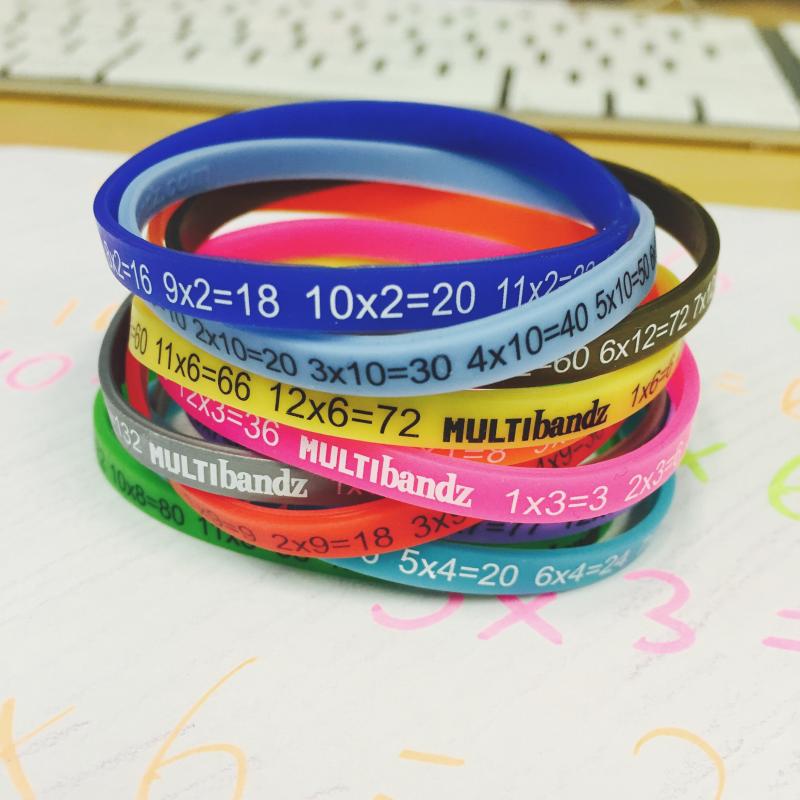Times Table Wristbands and Tips for Mathematics Teachers
 If you’re like most mathematics teachers, you may have a challenge on your hands when you teach the times tables. Rote learning—or writing endless facts over and over—just won’t cut it for most of your students. Here are some tips that can help you reach students of varied learning styles and abilities:
If you’re like most mathematics teachers, you may have a challenge on your hands when you teach the times tables. Rote learning—or writing endless facts over and over—just won’t cut it for most of your students. Here are some tips that can help you reach students of varied learning styles and abilities:
Set Measurable Goals
First of all, set measurable goals. When you offer a big prize to students who learn all of their times tables from 1 to 12 in a given amount of time, it may motivate a few gifted students. But how do you reach those for whom learning the entire set of multiplication facts seems like an insurmountable task? Teach the times tables by breaking them up into easily learned chunks. The most logical way: teach one family of multiplication facts at a time.
Provide Achievable Awards with Times Table Wristbands
Multibandz or times table wristbands allow students to learn one family of facts at a time. Each bracelet contains all the multiplication facts for a given factor—one bracelet for the ones table, another for the twos table, all the way up to the twelves table.
Offer these prizes to students who complete one set of facts. Give each student the first bracelet—the ones table—as a gift. When they learn those facts, award them the twos table bracelet. As they learn each times table, give them the next times table wristband in the series. These bracelets, therefore, serve as both reward and teaching tool.
Since students earn a bracelet for learning only one table, the awards are achievable by most students. Having a wearable reminder of each new times table they are learning makes the task even easier.
Your students can look at their bracelet while they ride to school, while they watch television, or any time of the day. After they learn their ones table correctly, award them the bracelet with the twos table, and so on. This way, the students have a visual memory aid to help them learn the facts in their next goal.
Glow-in-the-dark bracelets reward those who learn their fives table and above. With the sixes and above times tables, the students’ times table wristbands glow in the dark, allowing students to take one final peek at the next step in their learning before they sleep. With these bracelets, your students will dream in numbers!
Help for Students Who Have Difficulty With Math
Both teaching aid and motivation, these times table wristbands can be a great tool for teachers. But what about the kids who have difficulty learning even one set of facts in the times table? Perhaps they learn in a different way or have a math disability. How can you reach them?
First, Teach the Concept of Multiplication With Interactive Drama
It may be that some of your students don’t understand the concept of multiplication itself. A short play that the students participate in can help illustrate the concept and help the students learn their times tables in a fun, non-threatening environment. Choose students who are outgoing and not afraid to talk in front of others. Ask them to act out taking a trip to the beach for their class party.
Two students ride in three cars and arrive at the party at the same time. They talk among themselves about how many more students could have come if only more parents had brought two students each to the party. For instance, if only two more parents had brought two students each, the total students attending the party would rise from six to ten.
Next, another student chimes in to say that if each parent had brought three students to the party, even more students could have come. With only three cars, nine students could attend the party. This simple play illustrates the power of multiplication to increase numbers quickly. When students see how multiplication affects real-life situations, they may better understand the concept.
After Students Learn the Concept, Vary Teaching Methods by Learning Style
After the students understand the concept of multiplication, use varied tactics to teach each new times table. Help your students use previous knowledge to help them master the next step.
- For kinaesthetic learners: Those who learn best by movement and touch may grasp the information successfully when teachers use counters, small candies, or coins. Place them in rows that students can count by touching them. Students can regroup these objects to create new families of multiplication facts.
- For auditory learners: Those who learn best by hearing may benefit by learning songs or rhymes. Create rhymes or songs to help your auditory learners grasp each times table. If you’re not talented at songwriting or poetry, enlist the help of other teachers in your school to come up with catchy ideas that help auditory learners grasp the facts in each times table.
- For visual learners: Those who learn best by seeing could draw diagrams that show dots, stars, or other shapes arranged in rows of whatever number they are multiplying by. Help your visual learners come up with creative visuals that can help them remember multiplication facts.
Encourage students to come up with unique ways to help each other and themselves to learn multiplication. Again, as students master one multiplication table, reward them with the times table wristbands that will help them learn the next set of facts.
With teaching methods that reach students of every learning style and encourage peer mentoring, you will discover that your students learn more quickly and retain that knowledge for life. To order times table wristbands for your class, contact Handbands today.


Thank you for your interest in our Multibandz!
I've attached the link to our Multibandz page which provides you with details regarding the band. However, if you have any specific questions feel free to comment below and email us at [email protected]
Link to Multibandz: https://www.handband.com.au/au/catalogsearch/result/?cat=0&q=multibandz
Please see the top left corner of the page to change the location/currency.
Thank you
Christy
Please see the link attached below for more information on Multibandz:
https://www.handband.com.au/au/catalogsearch/result/?cat=0&q=multibandz
With our pricing, generally the you purchase, the less it costs per packet.
There are 12 wristbands within a packet, one for each number of the basic timetables.
If you have any more questions please comment below or email us at [email protected]
Thank you,
Christy
Please visit us as www.multibandz.co.uk for pricing and purchase information.
regards,
Michael
Please visit us as www.multibandz.co.uk, www.multibandz.com.au or www.multibandz.com for pricing and purchase information.
Thank you.
regards,
Michael